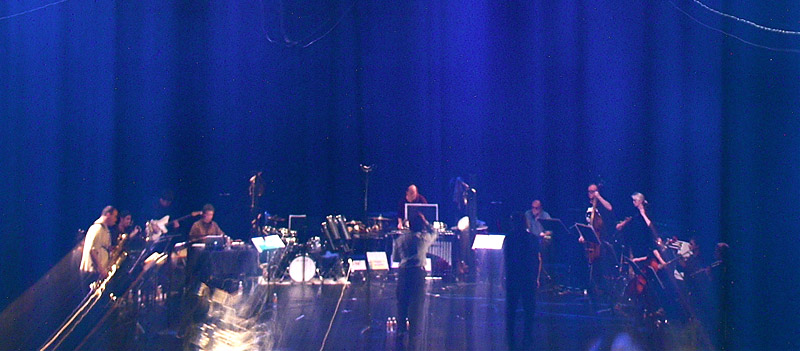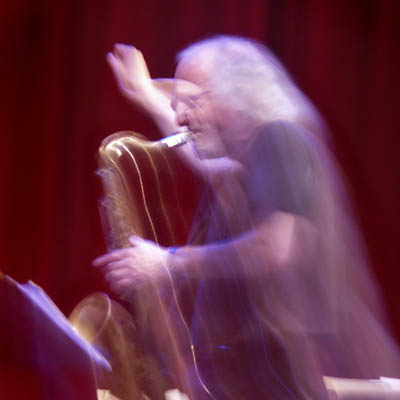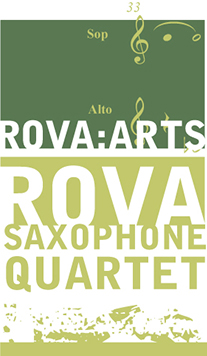Larry Ochs' The Mirror World (for Stan Brakhage)
Two versions of this piece are available for export: one for a sextet of Rova plus two percussionists; the other for a large ensemble of from 15 to 17 musicians. In the large ensemble version, Ochs, Raskin and Adams act as three conductors over different parts of the ensemble. The ensemble instrumentation is somewhat flexible but should include 1 el. guitar, 2 electronics, 2 percussionists, 1 or 2 bassists, 2 cellists or other strings, 2 trumpets.
General concept: According to Larry Ochs, the idea for The Mirror World (For Stan Brakhage) arose in part from concepts of musical space and gesture in his recent composing. The other inspiration for The Mirror World, as the work?s subtitle implies, is the revolutionary filmmaking of Stan Brakhage, the great "experimental" US film-maker. In composing this new piece, Ochs studied in depth the many levels (including levels-within-levels) on which Brakhage communicates ? including individual film frames; series of frames that, seen outside the projector, form a composite image; and a complete film as traditionally viewed on a screen. Ochs then adapted and built on these techniques for the medium of improvised music, organizing sound in a number of nested, overlapping, or even contrasting levels (e.g., the individual musician, multiple sub-groupings of musicians within the ensemble, the entire 13-piece ensemble). An important departure from Brakhage?s work in this piece is the role of improvisation?while the musicians and groups of musicians will follow pre-established rules or cues, any given performance of The Mirror World will evolve in the moment, pursuing an infinite number of possibilities. Therefore, as in all structured improvisation, while the listener will detect similarities across multiple performances, no two performances will ever be alike.

The sextet has been performed in an earlier form in Leipzig, Germany, with percussionists Paul Lytton and Raymond Strid; in Tokyo with drummer Tatsuya Yoshida (Ruins) and electronic percussionist Samm Bennett; in San Francisco with percussionists William Winant and Gino Robair (at Rovaté 2005) and in Venice, Italy with percussionists Fabrizio Spera and Cristiano Calcagnile. The large ensemble piece was premiered at Rovaté 2005, and so far is the only performance.

A recording of the piece has been mixed; details of a release forthcoming. Watch
this space for news.

Web 'reviews' of the San Francisco performance follow. Below these comments, please find a preview of the premiere performance written for the San Francisco Chronicle by critic Andy Gilbert. More details on the concepts behind the piece are included in the Chronicle piece.
"I never go to so-called 'contemporary events' because when I do they are always nostalgic of this or that, or simply derivative. They are never in the present. But this: I thought "this is now; this is the present."
"The concert was a triumph, and the works are brilliant, especially the second of the two works, performed by 17 musicians with Ochs conducting. The first work is one of Larry's high density compositions (for Rova plus two drummers), which isn't necessarily to everyone's taste but it seemed beautiful (in the sense, perhaps, that a storm can be) and remarkably coherent, despite the density."
The works are both dedicated to the avant-garde filmmaker Stan Brakhage (who died a couple of years ago at the age of 70), and the evening's event began with a screening of one of his short films. He was insistent that his films be "silent films," and they were all shown that way. So--lights out, screen descends, film shows (flickers and flares and forms of color). The film (called "Stellar") lasted around 4 minutes and then Rova and the drummers came on stage and played for around 35 minutes. After that another film short Brakhage film ("Comingled Containers") was shown--silently, which had the curious effect of providing a bridge back to reality from the intensity of the music while also, somehow, adding another layer of intensity to it.
The second half of the concert was structured similarly, but Ochs' second piece (the one for 17 musicians) was contemplative, delicate, and lyrical. It was utterly beautiful. I think you might have loved it. It all happens again tonight--and then a year or two of work is over. It's unlikely that another performance of these works will take place. It's too expensive to gather 17 musicians. I suppose this happens over And over in the music world."

"Rova and Rova:Arts offer one of the few true 'peak experiences' available
in this culture?and they seem do it on a regular, predictable basis. That's saying
something. Correction: That's saying everything."

Thursday, June 9, 2005 (SF Chronicle)
Rova Saxophone Quartet sounds out Brakhage's silence
Andrew Gilbert, Special to The Chronicle
The writings of Ezra Pound and Gertrude Stein, the choreography of Merce Cunningham and Martha Graham, the music of Bach and Messiaen ... it was all fair game for avant-garde filmmaker Stan Brakhage when it came to seeking inspiration for his meticulously designed poems in light.
In much the same way, saxophonist Larry Ochs has found a rich source of ideas for organizing sound in Brakhage's spellbinding silent creations. "As an artist, you're always looking for inspiration and concepts to come up against, to push your own processes out in a different direction, or suggest ideas for form that you haven't thought of," says Ochs, a founding member of Rova Saxophone Quartet, the bracing Bay Area improvised-music ensemble founded in 1977. A longtime fan of Brakhage's work, Ochs began seeing the aural potential in the films after buying the Brakhage DVD anthology released by Criterion in 2003.
"The shorter pieces just completely blew my mind," says Ochs, sitting on a sun-drenched bench in the well-tended backyard garden of the Berkeley home he shares with his wife, poet Lyn Hejinian. "There were all kinds of ways he was organizing visuals that struck me as musical. Of course, he never wanted music attached to his films, because he thinks symphonically."
Instead of attempting to create sonic canvases mimicking Brakhage's flow of images, Ochs has created two extended works that use his films as a point of departure in "The Mirror World (For Stan Brakhage)," an evening-length program at the Jewish Community Center of San Francisco's Kanbar Hall on Friday and Saturday.
The latest of Rova's annual presentations in which other artists are invited to join the quartet, the event features a sextet piece for Rova and percussionists William Winant and Gino Robair, and a large ensemble work for 15 musicians, including Winant and Robair, guitarist John Schott and cellist Joan Jeanrenaud, who has described Ochs as one of her primary creative inspirations since setting out on a solo career after two decades with Kronos Quartet.
Short films by Brakhage, presented by San Francisco Cinematheque, will be screened before, between and after (but not with) the musical performances.
While Rova's volatile improvisational aesthetic might seem antithetical to Brakhage's painstaking cinematic constructions, Ochs says he thinks the films "are very much like improvised music. You see them differently each time. If you go through it frame by frame, which isn't what he intended, it's amazing what's there."
Brakhage, who died in Victoria, British Columbia, in 2003 at age 70, was a leading force in American avant-garde film for almost half a century. Never able to support himself with his art, he taught at the Art Institute of Chicago for years, commuting every other week from his home in Colorado. He eventually landed a job at the University of Colorado at Boulder, where he taught from 1981 to 2002. Though he initially adopted a neorealist style, Brakhage started departing from narrative in 1955, with his first silent film, "The Wonder Ring," a meditative spatial study of a Chicago El platform, commissioned by artist Joseph Cornell. By the early 1960s, he was producing films at a speedy rate.
Inspired by the natural world and guided by a deeply sensual inner logic, his films are often packed with fast-changing images soaked in vivid color, though he could create an intense visual experience through minute changes in monochromatic fields as well. Many of his films summon an entire cosmos in less than 10 minutes (though some works extend for hours).
For Ochs, Brakhage's work suggests a densely packed environment for presenting information, though he's quick to point out that the films are a fixed medium, while his compositions are essentially "adventures in sound," in which he sets out elaborate rules for musicians that create parameters for their evolving interactions. Many of the improvisational systems Ochs uses in "The Mirror World" have been part of Rova's creative toolbox for years, but Brakhage's films have suggested new ways of thinking about presenting sound.
"They are full of beautiful shapes, and all kinds of things get thrown at you fast, coming at all angles," Ochs says. "It's all blowing by in a way that it would probably take hundreds of viewings to be able to know when something's coming. But somehow, you feel that you're seeing it all. That's what I was thinking about with the Rova material. It's like, we throw a lot of sonic information out really fast, but everybody has a chance to hear all of it. So we're trying to make people really comfortable at the same time they're thinking, 'Wow. How is all this sound happening at the same time?' And yet it seems like it makes total sense. Because that's the thing about Brakhage's film, they really make total sense right away. You go, 'OK, I think I know what he's trying to do.' "
